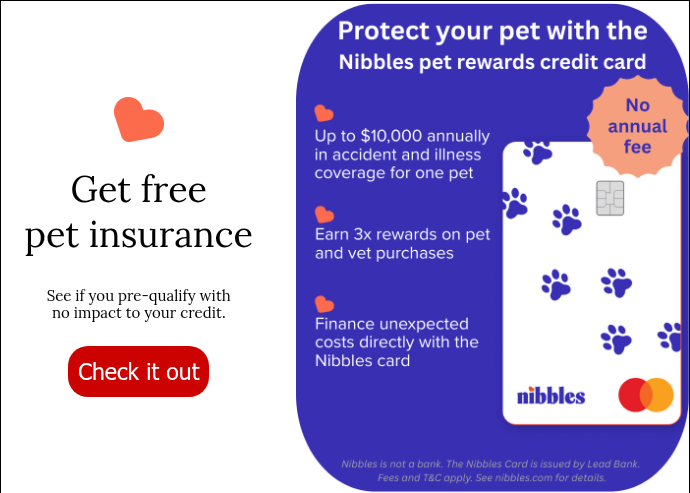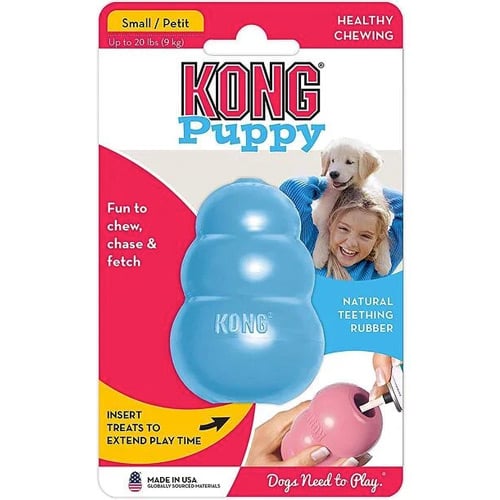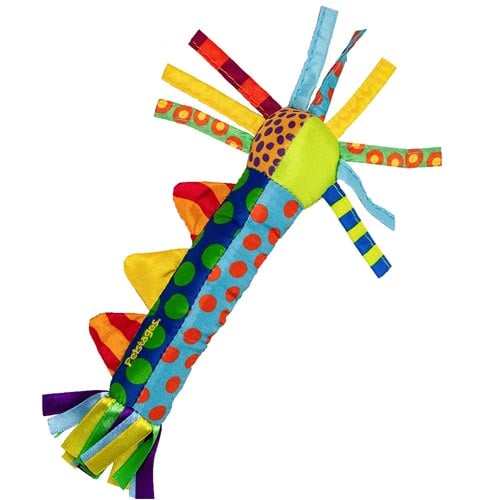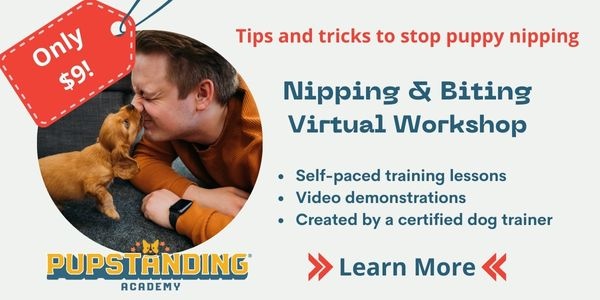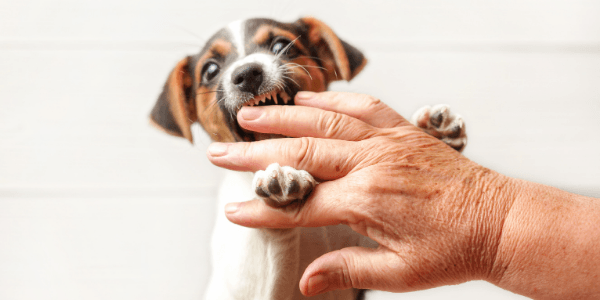
For some people, one of the most frustrating things about raising a puppy is dealing with nipping and biting.
The good news is that it’s entirely normal for your puppy to want to nip and chew on any and everything they see — the bad news is that their needle-sharp puppy teeth can really hurt!
You don’t want your puppy’s nipping turning into a lifelong habit. But, with consistent training and redirection, you can nip your puppy’s biting in the bud!
Beyond just nipping at you or other people, puppy mouths can get them in a lot of trouble. Puppies live as if nothing is off-limits and want to put everything in their mouths. Besides working on nipping behavior as outlined below, make sure you start off with puppy-proofing your home to help keep them out of danger.
Read on for tips on curbing puppy nipping, how to keep it from developing into a habit, and how to teach your puppy proper bite inhibition and impulse control. You can also tune in to listen to Cathy talk about puppies nipping and biting, and answer our audience questions during our Yappy Hour event:
How Long Does Puppy Nipping Last?
Puppies tend to start teething between three to four months old, and this process can last until they are six to seven months old. For those three months or so, you’ll likely see an increase in nipping and biting behavior as your puppy deals with the pain and discomfort of losing their baby teeth and their adult teeth coming in.
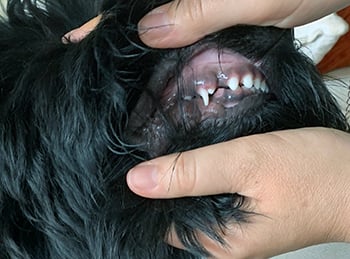 Preventive Vet office pup, Finnegan, shows us a close-up of his adult teeth growing in.
Preventive Vet office pup, Finnegan, shows us a close-up of his adult teeth growing in.
Your puppy should grow out of inappropriate nipping if you are consistent with the management of nipping and training alternative behaviors. However, be aware of your dog’s breed or breed mix. Certain breed groups, such as the herding group, have been selected for nipping behavior to better do their job herding livestock.
For example, if you have an Australian Cattle Dog, nipping might need to be managed for their entire life. Providing these types of dogs with appropriate enrichment and outlets (urban herding is a great one!) for these instincts will go a long way in making sure they aren’t nipping at you, family members, or even neighborhood children.
Why Your Puppy Is Nipping
It's helpful to understand the motivation behind your puppy's nipping so you can modify your training and management of your puppy. Your puppy might be nipping for different reasons depending on the time of day or how they're feeling. Knowing the why of your puppy's nipping will help you decide how to respond to it at that moment. Here are a few reasons your puppy might be nipping:
- They want to play! In this instance, redirect (as explained in the next section) to an appropriate dog toy.
- Your puppy is overstimulated. There might be lots of activity happening around your pup and they don't know what to do with all that excitement. Redirection is a great option here, or placing them in their puppy zone with an interactive toy can do wonders for helping them calm down.
- They want to chase something that's moving. Many dogs have what trainers call "high prey drive," meaning they like to chase moving things. I like redirecting nipping to a toy like a flirt pole in this instance to provide an outlet for this natural dog instinct. See Preventive Vet pup, Clover, learning the "drop it"cue while playing with a flirt pole.
- Your puppy is bored and looking for something to do. Puppies love exploring their world with their mouth. Provide lots of enrichment activities and enticing chews and toys to keep their brain busy.
- Your puppy is tired. Who doesn't get a little cranky when they're tired? Your puppy might need a nap in their crate or a safe, quiet spot like their puppy zone if they're excessively nipping.
- They want your attention. There's nothing quite like a good puppy nip that gets attention from humans. Once a puppy learns that nipping works to get your attention (whether it's "good" or "bad" attention), they're likely to try it all the time. Work on teaching your puppy that an alternative behavior, such as sit, works even better to get your focus and engagement.
- They might be hungry. Some puppies get nippier before mealtime — getting "hangry" isn't limited to just us people!
- Their gums hurt from teething discomfort. Give your puppy a soothing toy made specifically for teething puppies. Check out this list for my top picks for teething toys and other helpful tools for nipping puppies.
How to Stop Your Puppy From Nipping and Biting
Redirect, Redirect, Redirect
Redirecting means changing your puppy's focus from one thing to another. Doing so is helpful in many situations, but two of the most common ones related to puppy nipping are:
- You're trying to pet your puppy, but they keep wanting to nip and bite at your hands
- You enter the room or walk past them, and they chase and nip and your shoes, ankles, or clothing (especially if the clothing is baggy or loose – think pajama bottoms)
Use a Dog Toy or Chew as a Shield
Since puppies will nip a lot, stock up on some nipping "shields" to use to redirect their attention away from your hands or clothes. This could be a stuffed toy, or, for dogs that don't find stuffies as exciting as your moving hands or feet, using a bully stick as a shield could work. Find the distraction that is most enticing to your pup and use it!
The type of toy or chew your dog finds fun to chase and bite on might change throughout the day, so have a variety of options nearby. Stock a few toys in each room that are easy to grab and offer one to your puppy before they start targeting your hands, feet, or clothing. If your puppy likes to nip at you while you're trying to relax, using a flirt pole is a great way to play with them from a distance, and you can do flirt pole play even while you're sitting!
Make this toy fun by moving it around and playing tug with your puppy — using tug is a great way to use toys as rewards for good behavior. Plus, it's an excellent opportunity to practice your puppy's drop-it cue. Read more about how to play tug with your puppy the right way in "Playing Tug of War Without Encouraging Aggression in Dogs."
In this video, watch puppy Milo show how certain toys have different values depending on what else is going on around him. He absolutely loves to nip and bite at the flowing pink pants, and a stuffed zebra doesn't capture his attention. However, when his owner switches to a long rope toy and makes it move, he's much more interested! Sometimes redirection takes multiple tries before a puppy switches their focus.
For some puppies, redirecting to a toy or chew isn't quite "enough" in some circumstances. This is where switching to training treats or bits of their kibble can come in handy, and you can get some great training practice in!
Redirect to a Training Opportunity
A perfect time to practice polite greetings and interactions with your puppy is right before they usually start to nip. Keep small amounts of puppy kibble or training treats stored all throughout your home, so you're always ready to reward them for the behavior you like.
You can also grab one of these treats if your puppy is latched onto your pants in an epic tug battle. Place the treat in front of their nose. Once they let go of you, say "yes!" and toss the treat away from you for them to find. Now you have a chance to grab a toy, chew, or another treat to redirect your puppy to.
Is your puppy running towards you? Grab a treat and lure them into a sit. Or toss that treat to them when they are still a few feet away to stop any nipping (or jumping) before it begins. If they are too busy sniffing around for that treat, they aren't nipping you! Plus, they're learning what to do in those situations.
In my own experience, I always think of an exuberant six-month-old Wirehaired Pointing Griffon, who had a habit of rushing guests entering the home. She absolutely loved to nip and bite at ponytails and would often yank people by their hair. Ouch, right? Here's a basic outline of what we did to stop this dangerous behavior:
- The guest would enter the front door and immediately toss a treat to the dog behind her.
- After she ate that treat and turned back to approach the guest again, another treat would be tossed behind her.
- After a few repetitions of this, the guest would approach her and ask for a sit or a down. Reward with another treat and some attention for these appropriate behaviors. Once her initial excitement was gone, she was much happier to offer these behaviors instead of jumping and nipping.
Whenever her owners or guests weren't able to practice this routine, she would be behind a barrier, on a leash, or in another area of the home. She was a quick learner — after some practice, she began to anticipate that a guest entering her home meant a treat fell from the sky behind her. She'd look at the entering guest and stay where she was, looking around for the anticipated treat. Think about what you want your dog to do instead of nipping and write up a short training plan of how you'll practice it.
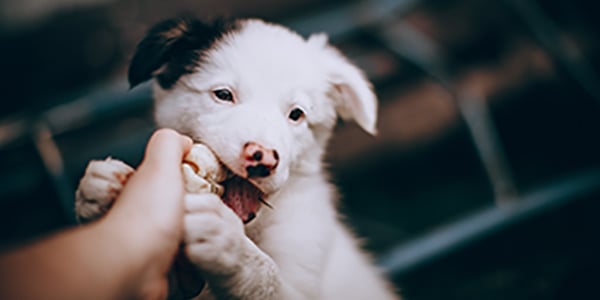
Use the "Karl Hack"
This training hack was created by Kim Brophey, author of the insightful book Meet Your Dog. I love this hack and recommend it to all of my puppy classes and private clients working on puppy nipping. Puppies need to play hard with other puppies, but in most homes, there aren't two puppies (and there often shouldn't be, for a variety of reasons). Even if there is another dog, they may not be all that into rough play with a puppy, and senior dogs often aren't able to escape the puppy crazy. Enter the Karl Hack!
All you need is a sturdy fake dog that your puppy can focus all of their puppy energy on. You don't want something too floppy – get a life-size fake dog closest to your dog's size and breed that can stand up to getting thrown around and chewed on. Choose one in a standing position so it best replicates playing with another dog. It's called a "Karl" because the first option Kim Brophey had was a Rottweiler toy that resembled the Karl from the children's books. The name just stuck!
Here are a couple of options for your own Karl:
Ideally, bring out Karl preemptively, a few minutes before your puppy's usual zoomie time or when they get extra nippy. This often is in the evening.
Use Karl to entice your puppy to play and let them beat up Karl as much as they want. Karl may need some stitches later on. You may stay involved with the play, moving Karl about to "interact" with your puppy, or allow your dog to just play with Karl on their own. This provides your pup with an appropriate outlet for all their energy and rough play. It redirects nipping to something other than you or other pets.
Once your puppy gets tired, then put Karl away until next time. Don't leave Karl out all day, save it for special high-energy or likely-to-get-nippy times of the day.
Click here to download the Karl Hack handout with more tips.
Here are a few photos from my clients of their puppies with their Karls after play. They tend to need a nap and will often drag Karl over to their bed to snuggle with:
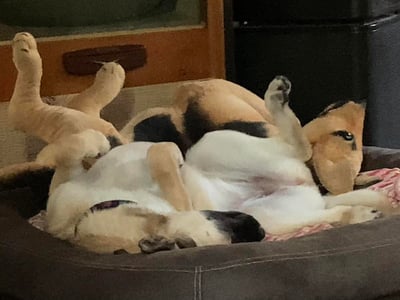
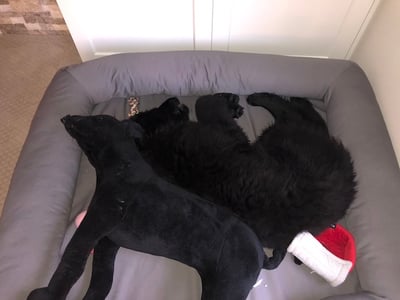
Puppy Interactions with Young Children or the Elderly
Puppy nipping can be especially painful for young children or elderly people. The best option is to prevent nipping from even starting in these situations by having the puppy in their playpen or on a leash under your control while around kids or senior citizens.
If they're separated by a baby gate or in their pen, you can give them a stuffed KONG or chew to create a positive association with the presence of children or different people. If they're on leash with you, reward them for calm, non-nipping behavior.
Interrupt the Nipping
If your puppy nips you, use a calm interrupter cue. This could be an "oops" noise. It's meant to be a cue for your puppy that they messed up and need to stop and think, not something said in a negative tone. The goal is that it makes the puppy pause their nipping — interrupting the behavior. Think of yourself as a game show host, even when a contestant gets the answer wrong, they don't scream and yell at the contestant. They simply say "wrong answer."
PRO TIP: This is going to sound counterintuitive, but do not yank or pull your hand away quickly when using an interrupter sound for puppy nipping. A hand being yanked away can actually entice your puppy to chase and bite at it more. Freeze all movement when you give the interrupter.
You can continue to play with your puppy after a short break if they calm down, but grab a toy or bully stick to redirect their biting to something appropriate. You can stop playing with your puppy if you feel they are getting too amped up and will continue nipping. Simply give your puppy something else to do, whether it's hanging out in their playpen or maybe it's mealtime.
Even if your puppy accidentally puts teeth on your skin, use the interrupter cue. Soon they'll learn that humans don't want any teeth touching them, even though other dogs they play with might.
If you've been working on teaching your dog name recognition, this is an even better way to interrupt unwanted behavior. If they've been taught that hearing their name means to stop what they're doing and look up at you, you can use this to your advantage! Make sure you reward them for choosing to look at you and not nip any time you say their name, with toys or treats. Learn how helpful this cue is in "How to Teach Your Dog Name Recognition."
PRO TIP: Your interrupter cue should not be the word "no." We tend to use "no" a lot as humans, and it automatically puts us in a frustrated state-of-mind. And because it's so overused, many dogs don't even know what "no" means.
Wait to teach your dog "no" until after they know what "yes" means. Instead, I like to use a cue like "oops!" or "try again."
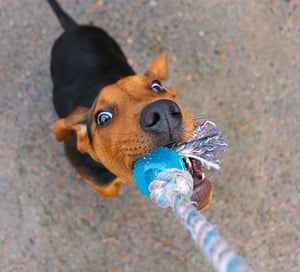 Stop Play or Interaction
Stop Play or Interaction
If your puppy is intent on putting their teeth on skin, there should be a consequence. One of the most effective consequences is what's called "negative punishment." This means you take something away to make a behavior decrease.
For nipping, we take away what the puppy wants at that moment — attention, play, and interaction. We do this to make the nipping decrease in frequency. Find out more about what "negative punishment" means and how to use it in conjunction with positive reinforcement in our podcast article "Dog Training — The Right and Wrong Way to Reward and Punish."
The goal is for your puppy to learn that teeth on humans = no more fun. This can take some repetitions for your puppy to learn, and your consistency is essential for success. If they sometimes get more attention or play, it will be tough for them to learn the association we want.
Use Your Puppy Zone
If your puppy does not stop nipping when you try to interrupt, it's time for some settle-down time in their puppy zone. Calmly remove your pup from the situation, picking them up (bitey end facing away from your face) and placing them in their pen. Give them an appropriate chew to work on, or check to see if it's time to eat. Many puppies get increasingly mouthy when they are hungry or tired.
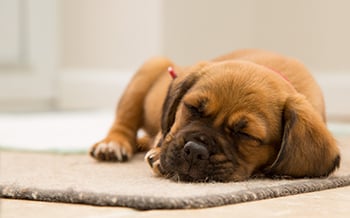
This is a modified time-out. We don't want them to view the pen as punishment, which is why it's important to give them an appropriate activity in their pen. Putting them in their puppy zone for a few minutes helps prevent any nipping from occurring. It also helps them learn about the association that nipping at you means you go away.
They don't need to be in their puppy zone for long. Many puppies who are put in their pen after getting too nippy during play usually pass out for a long nap. Just like toddlers, sometimes puppies show that they are tired or hungry by acting a bit cranky.
Provide Appropriate Chew Toys
Ensure that your puppy has opportunities to chew and nibble on appropriate things. Teething can be very uncomfortable for your pup, and they need something to gnaw on that soothes the pain. A puppy KONG is an excellent choice, especially if stuffed with frozen wet food or softened kibble.
The Cooling Teeth Stick featured below is another great option, as it can be frozen but still stays soft enough to prevent tooth damage. Avoid toys that they might shred and ingest, and don't give them bones or chews that are too hard and might crack their teeth. Check out this list of trainer-recommended products for nipping puppies for more safe toys and chew ideas.
When choosing the best toys for your puppy, it's helpful to consider their "chewsonality." They might be a nibbler, inhaler, or destroyer with their toys and chews. Find out your puppy's chewsonality by reading "3 Simple Steps to Choose the Best Chews for Your Dog."
Make Sure Your Puppy Gets Lots of Mental Enrichment
Excess puppy energy often means an increase in nipping or other unwanted puppy behaviors. While they are still young, physical exercise should be moderated. You can pair short sessions of physical activity with lots of mental exercise throughout the day! Enrichment is all about providing appropriate outlets for natural dog instincts and behaviors. Check out our article "Dog Enrichment: Toys, Games, and DIY Ideas" to get started.
Teach Your Puppy Leave It and Drop It
These two cues are crucial when working with a nipping puppy that wants to put everything in their mouth. Playing tug is a great game to practice Drop It with your puppy. Watch puppy Finnegan practice drop it while playing tug during his nippy puppy phase in this video:
When teaching these cues, one of the biggest mistakes we humans make is mixing up the meaning between the two. This can be very confusing for a dog learning what it is exactly that we're asking for. "Drop it" should be used if your puppy already has something in their mouth that you want them to drop. "Leave it" should be used before that item is in your puppy's mouth, and you're asking them to turn their head away.
Read step-by-step instructions for teaching these cues in these articles:
Get help for your puppy's nipping in our Puppy Essentials: Nipping and Biting Workshop
Includes unlimited access to self-paced training modules, video demonstrations, and more — all for only $9.
What NOT to Do When Your Puppy Nips or Bites You
Don’t Yell or Hit Your Puppy
Because the majority of puppy nipping is based in play or due to lack of bite inhibition, adding an aversive punishment when it happens can have unintended consequences. You don’t want your puppy learning that interaction with you means unpleasant things happen to them. As mentioned above, instead, you can use "negative punishment" to take away something your puppy wants and likes to decrease the unwanted behavior.
More importantly, punishing the behavior with yelling or hitting, even tapping them on their noses (often called “bopping” in an effort to make it sound less cruel), or holding their mouth shut doesn’t show them what to do instead. This type of behavior ("positive punishment")can damage the trust and sense of safety they have in you. To learn more about why you should not use these types of punishments with your puppy, read our article “Dog Training Aversives: What Are They and Why You Should Avoid Them.”
Raising a puppy is hard work, and many new puppy owners experience what's called the "puppy blues," where they feel exhausted, anxious, and depressed. Puppy nipping and biting is often the main trigger of an outburst of anger from us humans — getting nipped hurts! It can be hard to not want to yell at our puppies, but it's worth it for your relationship to try and stay cool, calm, and collected at the moment. If you're feeling overwhelmed with your puppy's behavior, reach out to us or your dog trainer for support. We're here to help.
Don’t Entice Nipping or Biting
This can be hard, but try to keep your movements (especially your hands) slow and smooth. Fast or jerky movement can entice more play, nipping, and lunging. If your puppy nips your hands, use the interrupter as explained above, and FREEZE. If you pull your hand away quickly, they’ll almost always want to keep chasing it.
Running children can be a big enticement for puppies to play and nip as they chase heels. If your children are running around and playing, keep your puppy separate or have them on a leash under your control. This makes it easier to reward calm behaviors around excited kids.
Loose clothing, such as long skirts, wide-legged pants, or loose sweatshirt sleeves can also entice nipping. Consider keeping these items on the hangar while your puppy is going through their nipping phase, or don’t wear them around your puppy.
Don’t “Bite Your Puppy Back”
For some reason, this response to puppy nipping has been making the rounds on social forums, and you should completely avoid this. First off, your puppy knows you’re not a dog, so biting them back doesn't have the same meaning as when a dog does it to them. Second, as with other aversives, it can have unintended consequences of increased nipping or unwanted aggressive responses.
You don't want your puppy viewing you as threatening or something to be scared of. That's not setting you up for a trusting and healthy relationship. Third, it’s really just asking to be bitten back, and do you really want to be bitten in the face with those sharp puppy teeth? There are better ways to handle puppy nipping.
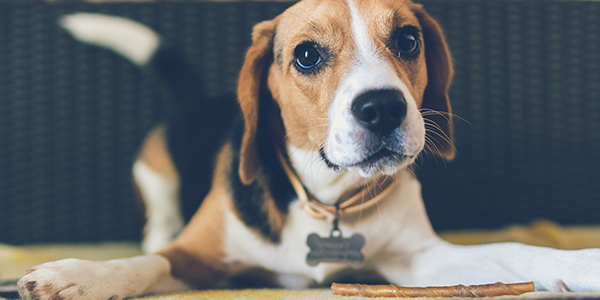
Is Your Puppy’s Nipping a Sign of Aggression?
A snappy puppy may be worrisome, especially when paired with growling and barking. In most cases, nipping, growling, lunging, and barking are all part of your puppy's play behavior. It is rare for young puppies to be exhibiting truly aggressive behavior. If you are worried that your puppy is acting aggressively, I recommend consulting with a certified dog trainer or canine behavior consultant who can work with you one-on-one. They will observe your puppy's body language, watch for any environmental triggers for possible aggressive behavior, and help you develop a training plan.
If the result of the consultant's report is that your puppy isn't aggressive then that's a bonus, and you'll get some good training tips for curbing the unwanted nipping behavior. However, if the consultant believes that your puppy is displaying aggressive behaviors, then you'll be catching it early and can start a behavior and training program, so it doesn't become a lifelong issue.
When Lunging and Biting is a Sign of Resource Guarding
If your puppy is lunging or biting when you reach for a toy, their food, or another type of resource (such as where they are resting on the couch or in a dog bed), this might be a sign of resource guarding. If you believe your puppy is resource guarding, please connect with a certified dog trainer or behavior consultant who can help you through a behavior modification plan. You can connect with me in my virtual Resource Guarding Foundations course that includes self-paced modules, multiple one-on-one coaching sessions, and personalized training plans.
- Don't play with your puppy's food while they are eating, or grab at a chew while they are enjoying it. Think how annoying it is when another person reaches over to your plate and plays with or takes your food. Allow your puppy to eat and chew in peace.
- If you have children in your home, teach them that when the puppy is eating that they should not approach or interact. Feeding your puppy in a safe space, such as their puppy zone or crate, can help prevent any accidental intrusions of their "me" time by curious kids.
- Always listen to and respect your puppy's warnings. If they freeze when you approach them, or start to growl, stop approaching and think about what you can do to build positive associations with your approach. For example, as you will see in the video below, the dog learns that an approaching person means a piece of chicken appears. With repetition, the dog's emotional response to someone approaching them while eating changes from one of fear (that they'll lose their food bowl) to one of excitement (that person = chicken! Yahoo!).
- Focus on teaching your puppy that someone approaching them while eating means something good happens to them. A certified trainer will help you learn how to do this, and their training plan should look similar to what's shown in this video:
Aggressive Biting
If your puppy has body language indicative of aggression along with nipping and biting, it's time to reach out to a professional. Often, aggression is rooted in fear, and you might see your puppy react defensively to certain things that scare them. This usually is seen in a puppy with ears pinned back against their head, tail tucked, baring teeth, and wide eyes where you can see the whites.
Along with fear, aggression could be related to pain or another underlying medical cause. The first step when addressing aggressive behavior is to schedule a veterinary exam to rule out medical issues.
Learn Your Puppy’s Body Language
Learn canine body language to better determine why your puppy might be nipping or biting besides normal puppy teething or play. Things like ear position, the tenseness of the body and face, the shape of the eyes, and the position of the tail all communicate your puppy's emotional state. Fortunately, there are lots of resources available for puppy owners. Get started by checking out our Recommended Resources to Decode Canine Body Language.
Stick With It
A nipping puppy can be frustrating — take heart in knowing that every puppy owner has been there and feels your pain. Fortunately, puppy nipping doesn't last forever as long as you stay consistent with your puppy's training now. Stock up on some nipping "shields" and start teaching your puppy what you'd like them to do instead of nipping you. You've got this!
Let us know what questions you have about your puppy's nipping and biting in the comments below!
Related Resources
Shopping List: Trainer Favorite Products for Nipping & Teething Puppies


